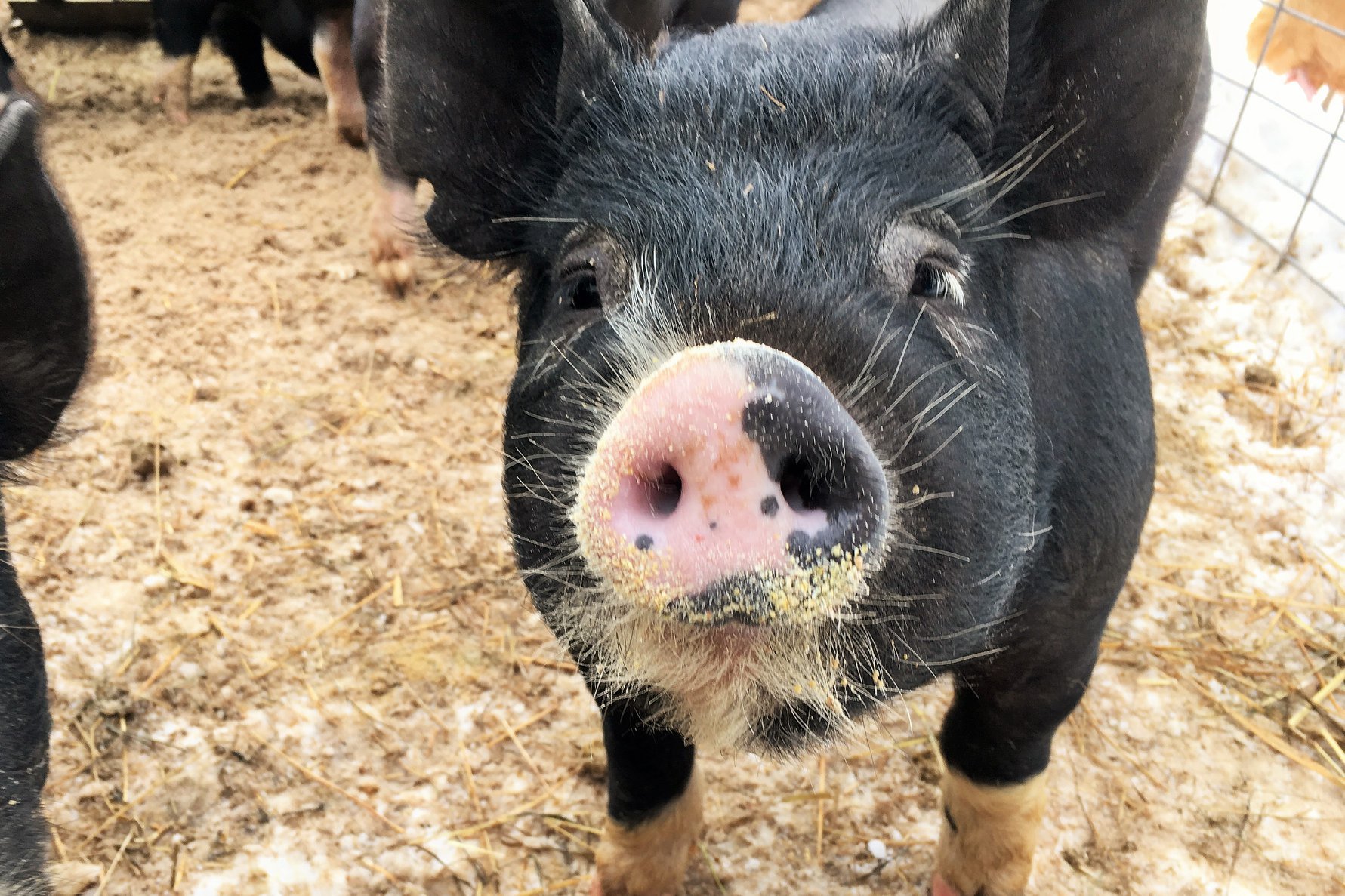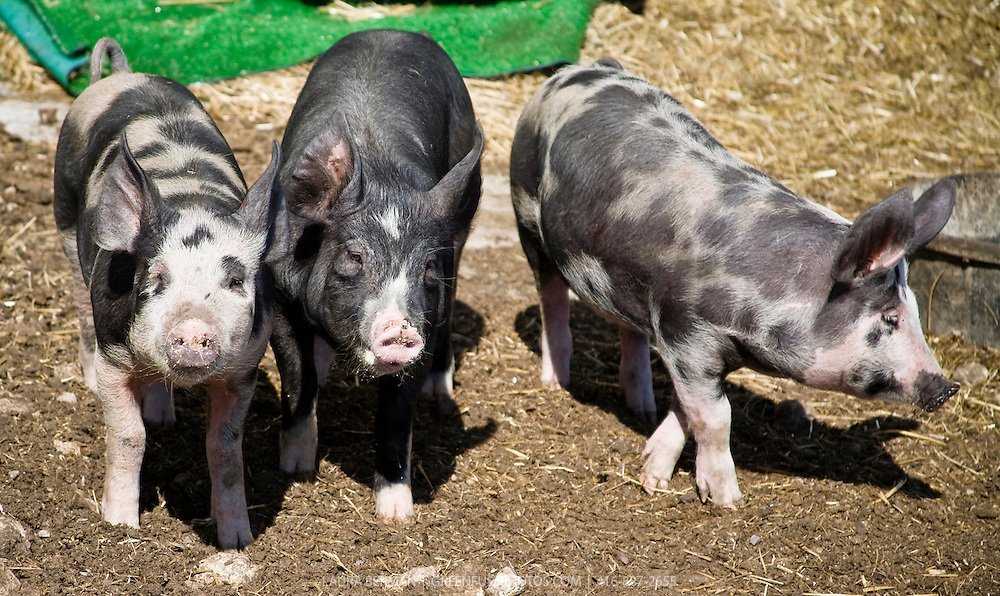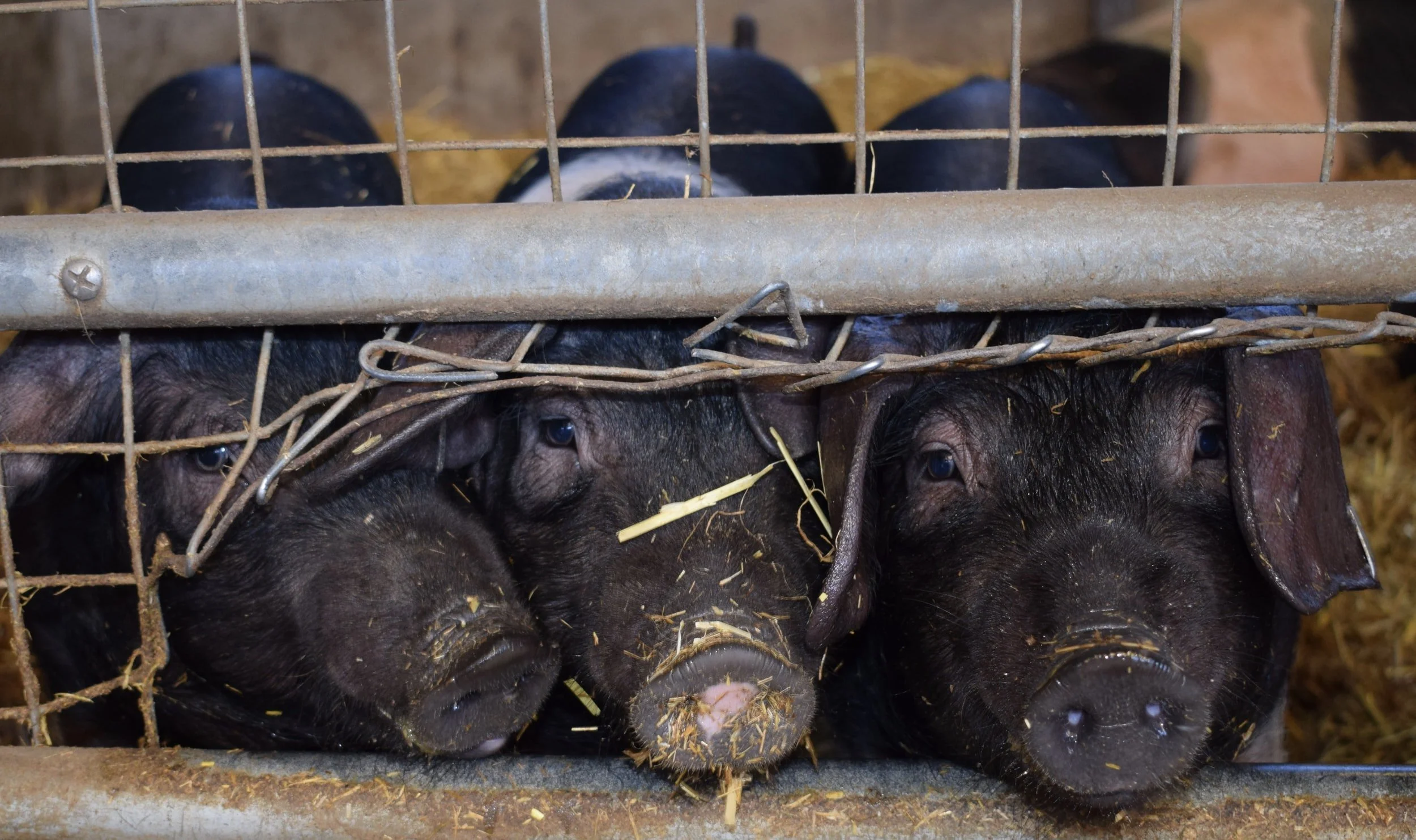Raising Berkshire Pigs: A Comprehensive Guide to Success
Discover > Raising Pigs > Raising Berkshire Pigs: A Comprehensive Guide to Success
Dive into this guide to explore the rewarding world of raising pigs, particularly the Berkshire breed, known as the 'Kobe beef' of pork. We'll cover everything from dealing with lard pigs to the finer points of how to produce heritage breed piglets. You'll discover the ins and outs of nurturing Berkshire feeder pigs, choosing a pure-breed female for your breeding program, and so much more. Let's embark on this journey into breeding pigs together, ensuring your success in this venture.
Berkshire pigs, also known as "Berkies," are a heritage breed from England favored for their high-quality, well-marbled meat. They're intelligent, robust, and easy to raise, adapting well to various environments. These pigs are not only a source of delicious pork, but they can also be a financial asset for farmers selling heritage-breed meat. Furthermore, Berkshire sows are exceptional mothers, aiding in a smoother breeding process.
The History of Berkshire Pigs
The Berkshire pig breed originated around 300 years ago in Berkshire, England, where it was perfected to have its current distinct characteristics such as black fur and flavorful meat. Since its English origins, Berkshire pigs have spread across the globe, with populations found in countries like Japan, the United States, Australia, and New Zealand.
In the early 19th century, the Berkshire pig breed began to take shape due to the import of hogs from East Asia, which played a crucial role in improving native strains. This ultimately led to the establishment of a Herdbook in 1885 that fixed the current characteristics of Berkshire pigs. The breed initially originated in the Thames Valley, possibly around Wantage, circa 1790. It started as a large, tawny red pig with black spots, featuring pendulous ears and a long, thick body.
Over time, Berkshire pigs have evolved to be smaller and less coarse than their early predecessors. Renowned for their intelligence, these pigs are well suited for extensive pig farming systems. The meat from Berkshire pigs is highly prized for its juiciness, flavor, and tenderness, being pink-hued and heavily marbled.
Several imported breeds, including the Berkshire, significantly influenced the history of heritage swine in general. Historically, the Big China and Irish Grazier breeds were also widely used to improve common stocks. With their rich history and delectable meat quality, Berkshire pigs continue to be a popular choice for both small-scale and large-scale pig farming enterprises around the world.
Physical Characteristics
Berkshire pigs are known for their distinctive appearance, making them easily recognizable among other pig breeds. These pigs have a predominantly black body with white points on their feet, nose, and tail. Their legs are relatively short compared to their body size, giving them a sturdy and compact stature.
The head of the Berkshire pig is quite small in proportion, which enhances the appearance of its broad back. Their face has a dish-shaped structure, featuring a large jaw and an upturned nose with a short snout. When observed from the side, their nose appears inverted. Berkshire pigs have pricked ears that point upwards, adding to their unique appearance.
Another remarkable aspect of Berkshire pigs is their dark coat color. Due to their black hue, they are less likely to experience sunburn compared to lighter-colored pigs. This is an added advantage for farmers, as it reduces the need for sun protection measures.
Not only are Berkshire pigs visually appealing, but they also possess an intelligent and rugged nature, making them suitable for both extensive piggery farming systems and confinement. This adaptability makes them ideal for small-scale production and spacious backyard farms, as they can thrive in various environments.
Diet Requirements
Feeding Guide for Piglets
Piglets, younger pigs that weigh less than 40 pounds, should be introduced to a solid diet through creep feeding while they are still suckling. The dietary needs of piglets will increase daily with their weight gain. It is essential to provide them with a high-quality, easily digestible feed to ensure proper growth and health. Make sure to provide fresh and clean water at all times.
In the initial stages of their life, piglets require a diet that is high in protein, vitamins and minerals. Key components of their diet include:
Starter feed: A specially formulated diet to help the piglets transition from their mother's milk to solid food.
Protein: High-quality protein sources, such as soybean meal, canola meal or fishmeal, are necessary for building muscle tissue and body mass.
Vitamins & Minerals: Piglets need essential vitamins and minerals like vitamins A, D, E, and K, as well as calcium, phosphorus, and iron for proper growth and development.
Feeding Guide for Adult Pigs
Adult Berkshire pigs require a balanced diet to maintain their overall health and reach optimal weights for meat production. Growing and finishing pigs (those weighing 40+ lbs.) require a diet that supports their steadily increasing body mass. Here are some important aspects to consider when feeding adult pigs:
Maintenance feed: A diet aimed at providing all the essential nutrients, including energy, protein, vitamins, and minerals, to keep adult pigs healthy and active.
Energy: Grains such as corn and barley are excellent sources of energy that should be included in an adult pig's diet.
Protein: Protein sources like soybean meal and canola meal help promote lean muscle growth and maintain the pig's body mass.
Fiber: An adequate amount of fiber is needed for a healthy digestive system. Incorporate hay or other forages to meet their fiber needs.
Vitamins & Minerals: Adult pigs still require vitamins and minerals, especially when it comes to maintaining strong bones and overall health.
Remember to adjust the diet of your Berkshire pigs as they grow, ensuring they receive the nutrients necessary for proper growth and development. Regular checks on their health and weight gain will help keep them on track and produce high-quality meat for your family's needs.
Housing and Environment
Setting Up A Pig Pen
In the grand adventure of rearing Berkshire pigs, ensuring they have a secure and cozy habitat is key. Begin by setting up a pig pen that allows for adequate space and movement. A fenced area with secure boundaries will ensure that the pigs do not wander off. Consider providing a shaded area as well, as pigs can be sensitive to high temperatures and direct sunlight.
Inside the pig pen, make sure there is a dry, clean spot for the pigs to sleep and rest. Additionally, include a wallow area where the pigs can cool off and enjoy themselves. A wallow can consist of a simple mud pit created by mixing water and soil. Furthermore, ensure access to clean water for the pigs to drink.
Important Factors in a Pig Environment
Shelter: Provide a suitable shelter to protect the pigs from adverse weather conditions. A well-ventilated barn or a simple three-walled structure can be effective. Ensure the shelter remains dry and clean to minimize disease risks.
Feed: Offer high-quality feed to ensure optimal growth and health in Berkshire pigs. They can consume a variety of foods, such as forage, grain, and vegetables. Commercial pig feed can also be used.
Cleanliness: Maintain a clean environment by regularly removing waste and bedding material from the pen. Proper sanitation practices can prevent odor issues and disease.
Socialization: Allow the pigs to socialize with each other, as they are social animals. However, it's important to monitor their behavior to ensure they do not become aggressive or injure each other.
Health and Wellness
Common Diseases
Berkshire pigs can be susceptible to various diseases, similar to other pig breeds. Some common diseases include:
Porcine Reproductive and Respiratory Syndrome (PRRS): This viral disease affects the pigs' respiratory and reproductive systems, causing reproductive failure and respiratory problems.
Porcine Epidemic Diarrhea (PED): A highly contagious viral disease causing severe diarrhea and high mortality rates in piglets.
Swine Influenza (SIV): A respiratory disease caused by different strains of the influenza virus.
General Care
Proper care and management are crucial for the overall well-being of Berkshire pigs. Some general care guidelines include:
Nutrition: Providing a well-balanced and nutritious diet is essential for growth, reproduction, and overall health4. Ensure proper feed and clean water are available at all times.
Housing: Adequate shelter should be provided, with proper ventilation, bedding, and protection from extreme weather conditions5. Clean and hygienic living conditions are vital in disease prevention.
Socialization: Berkshire pigs thrive in social environments, so it's important to provide opportunities for social interaction with other pigs6.
Health monitoring: Regular health checkups and vaccinations can help prevent and manage potential diseases. Maintain a close relationship with a veterinarian for proper health care and guidance.
Breeding Berkshire Pigs
Selecting a Sow or Boar
In the world of Berkshire pig farming, the key to a triumphant breeding operation lies in the choice of a robust boar and sow. Look for pigs with good genetic traits such as muscle development, fertility, and temperament. It's important to ensure that the pigs are from different bloodlines to prevent inbreeding issues. The average Berkshire pig will be between 27 and 29 inches tall, fitting into the average to large breed category.
The Breeding Process
Once you have selected your sow and boar, you can begin the breeding process. Berkshire pigs reach sexual maturity at around 6-8 months old, but it's best to wait until they are at least 8 months old before attempting to breed. This ensures that both the sow and boar are physically mature enough to successfully produce offspring.
During the breeding process, monitor the sow for signs of estrus, such as swelling of the vulva and increased interest from the boar. Once the sow is in estrus, you can allow the boar to mate with her. After successful breeding, the sow's gestation period is approximately 114 days, or about 3 months and 3 weeks.
Berkshire pigs can be raised on pasture with supplementary feed depending on the season. It's advisable to provide a no-chemical environment and seek the help of a vet if the pigs get ill. With proper care and attention, your Berkshire pigs will thrive and make a valuable addition to your homestead or hobby farm.
Marketing and Selling Berkshire Pigs
Finding a Market
If you're in the business of rearing Berkshire pigs, locating an ideal marketplace to peddle your top-notch pork is a must. As a heritage breed known for its rich flavor, juiciness, and tenderness, Berkshire pork appeals to customers who appreciate quality. To reach these customers, consider partnering with local specialty shops, restaurants, and high-end grocery stores. Participating in farmers' markets and selling directly to consumers can also be an effective way to create a loyal customer base.
Promote the benefits of Berkshire pork, such as its depth of flavor and its unique appearance, characterized by its black coloring with white "socks" on its feet. Social media platforms and word-of-mouth referrals can be powerful tools to attract potential buyers' attention.
Setting Your Price
To set prices for your Berkshire pigs, consider the following factors:
Cost of raising the pigs: Calculate the total cost of raising your Berkshire pigs, including feed, water, housing, and any medical expenses. This figure will provide a baseline for pricing your pork, ensuring you cover your expenses and turn a profit.
Quality of the pork: Berkshire pigs are known for their marbling and tenderness. If your pigs provide top-quality pork, you can command a higher price for their meat.
Local market pricing: Research the prices of similar products in your area to gauge the appropriate price range for your Berkshire pork. If possible, make a comparison to other heritage pork breeds as well to capture the premium nature of the product.
Customer preferences: Consider the demographics of your target market and adjust pricing accordingly. For example, customers who prioritize high-quality, unique, and ethically-raised meat products may be willing to pay a higher price.
Frequently Asked Questions
What is the optimal growth rate for Berkshire pigs?
The optimal growth rate for Berkshire pigs varies depending on the individual pig and their environment. However, it is generally considered that Berkshire piglets grow quickly due to the high milk production of their sows. High milk production is sufficient for their large litter size, which helps the piglets to grow at a favorable rate.
How much do Berkshire pigs typically weigh at different stages?
Berkshire pigs fit into the average to large breed category. At birth, piglets only weigh a few pounds. As they grow, mature male pigs can reach an average weight of around 600 pounds, whereas mature female pigs tend to be slightly smaller, averaging around 400 pounds.
What makes Berkshire pigs good for breeding?
Berkshire pigs are known for their excellent maternal instincts and milk production. They have large litter sizes, typically around 8 to 10 piglets, and their ability to produce sufficient milk for the piglets makes them highly desirable for breeding. Berkshire sows not only take care of their offspring well, but they also have an extended gestation period of around 116 days, allowing for ample development of the piglets before birth.
At what weight should Berkshire pigs be slaughtered?
The optimal weight for slaughtering Berkshire pigs depends on the specific breed and the producer's preference. Generally, Berkshire pigs can be slaughtered for meat at a weight of around 200 to 280 pounds. This weight range allows for the best balance of meat production and quality, ensuring juicy and tender cuts of pork.
What is the best feeding strategy for Berkshire pigs?
The best feeding strategy for Berkshire pigs varies depending on factors such as age, weight, and overall health. It is essential to provide a well-balanced and nutritious diet, which can include grains, vegetables, and other supplements, to ensure the pigs maintain optimal health and growth rates. Monitoring the pigs' body condition closely and adjusting the diet accordingly is vital to achieve the desired results.
Is it profitable to raise Berkshire pigs on pasture?
When one handles the rearing of Berkshire pigs on pasture with efficiency and effectiveness, there's a good chance of seeing a nice profit. Providing enough high-quality forage, rotating pastures regularly to avoid overgrazing, and maintaining a sanitary living environment are essential factors to consider. The pasture-raised pigs also tend to have higher-quality meat, as the grass and forage improve the marbling of the pork, which can increase the overall profit when selling the meat.









